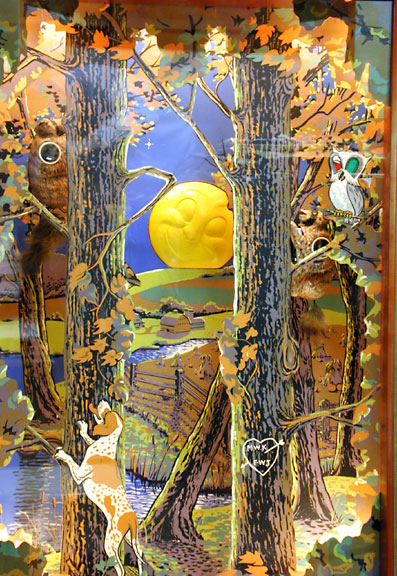
Coon Movement
The front of the game shows the score at the top and a rating, "Marksman", at the bottom. There are two trees, the dog barking up the left tree and the owl, with red and green eyes, sitting in the right tree. There are various branches obstructing the view of the two coons. There is one on the left side of the left tree, almost to the top of the tree. The right coon is next to the owl and is on the right side of the right tree. There is a moon setting in the background across some fields.
The coons motion is easy to describe. The coon climbs one side of the tree. When the coon gets to the top, it turns and hides behind the tree and climbs to the bottom. Once at the bottom, the coon will pop out from behind the tree either on the left or the right side, and will start climbing again. The appearance on the left or right is random.
Coon Hit
When the hunter manages to hit a coon with a ray of light, the coon falls and rotates behind the tree. It stays hidden (dead?) until the other coon reaches the top or the player shoots again, whereupon the coon will suddenly appear either on the left or the right side of the tree and start climbing again.
When a coon is hit, he whines and one of the eyes of the owl will light. If the left coon is hit, the whine sound is higher than the right and the left red eye of the owl will light. The right coon, when hit, will light the green right eye of the owl and make a lower whining sound. The moon also lights up and shows a hidden face, the man in the moon, when lit.
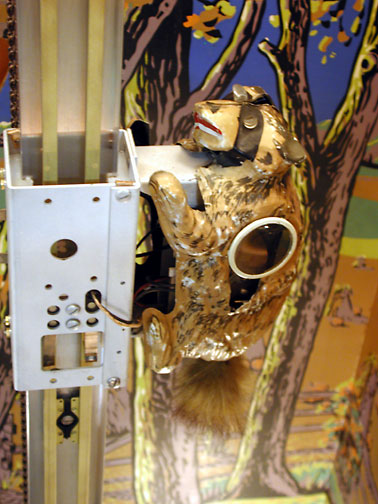
A Game
A game consists of 20 shots. A perfect game will provide 20 hits and be rewarded with a Expert rating. A marksman rating is rewarded if 12, 13. 14. or 15 hits are scored, a sharpshooter rating if 16, 17 or 18 hits are scored, and an expert rating if 19 or 20 hits are scored. Games normally cost 10 cent or three games for a quarter.
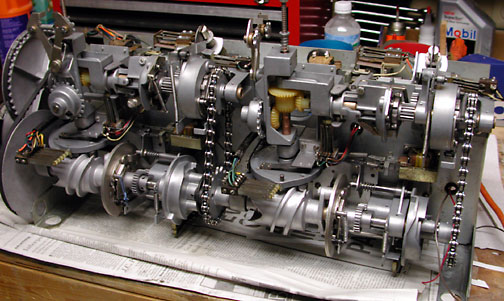
How Does It Work
The coon hunt mechanism is very complicated. The left side controls one coon and the right side controls the other. The bottom half controls which side of the tree the coon climbs and the top half helps the coon climb up and down. There are three major assemblies for each function.
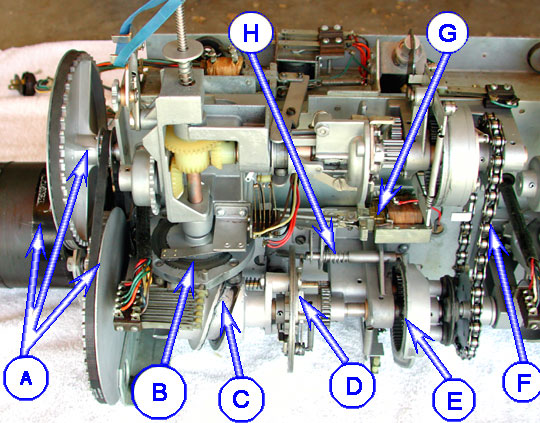
(Note only the bottom mechanisms are labeled. The top mechanisms are explained further below.)
Which Side of the Tree
- The motor and reduction pulleys provide power to the game. The final pulley rotates an axle all the way through to the chain drive at F.
- This is the turntable that rotates the tree. It has pins on the bottom that fit into a spiral cut guide, C. The turn table can rotate into one of three posistions, left, back or right, thus showing the coon or hiding it depending on the position.
- The spiral cut guide can rotate either direction depending on what cog the ratchet clutch selects.
- The ratchet cogs are rotating both directions. Little arms on the cog wheel reach out and are stopped by one of two pins, H and another not visible. If the pin is moved out of the way, the arm engages one of the counter rotating cogs and causes the spiral guide, C, to rotate in the direction selected. There are two sets of cogs, each rotating the opposite direction, so depending on which cog is selected, the tree can rotate either direction.
- Planetary gears provide the counter rotating cogs. The pins, H, that allow the cogs to engage are resting on the edge of the planetary gears, and provide for the random selection of direction.
- The chain provides power to the upper functions, which control the climbing of the coon.
- The solenoid is activated when the coon reaches the top and the bottom of the tree, first rotating the coon behind the tree and then rotating it out to either the left or the right side. There are some pins on top of the turntable, B, that prevent the tree from rotating beyond the left or right sides.
- The pins control the random motion of the tree. There are two that rest on the rim of the planetary gear, one from each side, and these determine which will move out of the way and allow the cogs of the ratchet to engage, spinning the spiral guide one direction or the other.
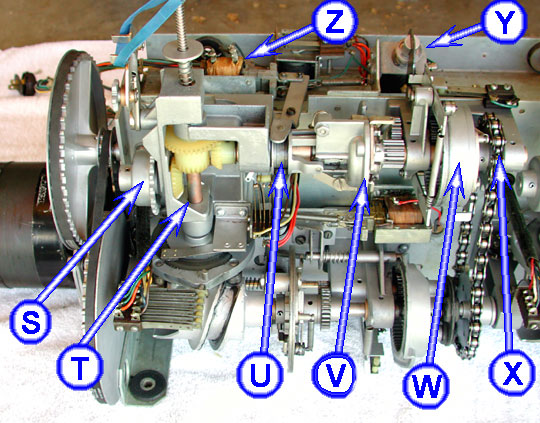
Climbing Up or Down
(This is the same picture as above, only the top mechanisms are labled. The bottom mechanisms are explained above.)
X. The chain provides power to the upper mechanism and is driven by a shaft passing through all the lower mechanims.
W. The planetary gears are engaged by the solenoid, Y, and provide for reverse rotation required to make the coon go down instead of up.
V. The ratchet cogs engage the upward bound rotation unless they are moved to the right, where they engage the downward rotation. The movement is controlled by the solenoid, Z, which pushes the collar, U, to the right.
U. The collar is controlled by the solenoid, Z. At the normal position, it allows the ratchet cogs to catch the rotation that will cause the coon to climb. When the solenoid pulls, it forces the collar to the right, which allows the ratchet cogs to either rest and not move (dead coon), or if the planetary gear is operating, to move the coon down.
T. These differential gears provide for coon movement no matter which direction the tree is turning. The output sprocket, S, will continue to move the coon up and down even when the tree has rotated to a new position.
S. The output sprocket is conected to the coon carriage on the tree with a chain, and drives the coon up and down.
Y. This solenoid turns the planetary gear on and off. It turns the reverse gear on when it is engaged.
Z. This solenoid controls the direction of travel for the coon. When it is reset, the coon will climb. When it is engaged, the coon will be driven down if the planetary gears are engaged or will prevent the coon from moving if they are not rotating.
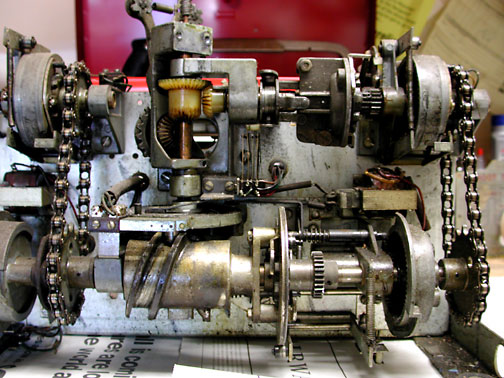
Dirty Mechanism
This is an example of a dirty mechanism, showing lubrication and dirt overy 50 years old. Do not attempt to operate your game if it looks like this. The Nylon gears in the differential are very suseptable to braking off teeth and advance wear will occur of the game is played.
During restoration, I disassemble each individual mechanism, clean it all, and then assemble. I check for proper function by rotating the input shaft by hand, making sure nothing is binding and all the clearances are properly adjusted.
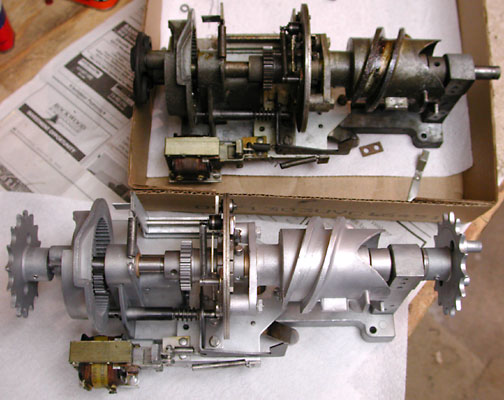

The cabinet is painted candy apple red over a gold base coat. There is some antiquing on the front and around the frame which is accomplished by putting a light tan base and then swiping a darker glaze across the top.
The Coon Hunt also appears in the sample section of the museum. A video of the game being played is included.
